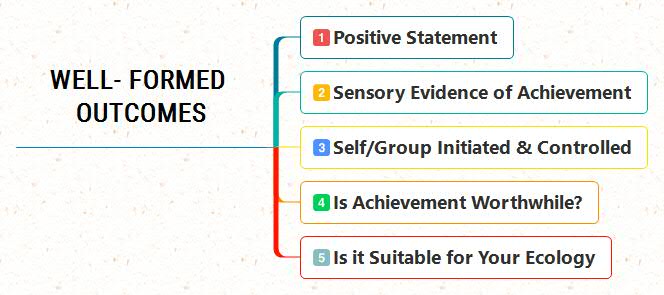In NLP goal setting, “well formed outcomes” are used. It is preferred over the popular SMART goal techniques as it engages our senses and emotions. Goals are designed by subjective experience representations and derive power from the emotions within.
There are many goal-setting techniques that can be used for creating powerful goals. Well-formed has been a popular technique, and a lot of variants of this technique are in use.
Well-formed outcomes are useful
- To get Clarity on what it is that we want to achieve?
- Shaping the future outcomes in specific ways, the way we want them to be right in the beginning.
- Get clarity on the resources needed to get to the goal
- Improve the potency of our goal so that we can succeed.
- Overcome any obstacles in our thinking that can hinder the successful achievement of the goal.
- Identify the initial steps needed to achieve the goal.
Well Formed Outcomes
1. Well-Formed Outcomes – The Initial Model
Although NLP was founded in 1970. However, it continues to evolve. You will find one such documented well-formed outcomes model in the book by Robert Dilts.

The expectations or conditions to be fulfilled by a well-formed outcome are:
- State outcome in positive language.
- Visualize a sensory evidence/description of the outcome, and the steps required to get there.
- Initiated and maintained by self/group desirous of the goal/outcome.
- Is it worthwhile to you? Check the advantages and disadvantages.
- Is it suitable for you Ecologically?
You may identify different ways to achieve the outcome as part of the goal setting. Deciding on a specific first step that is achievable is important when setting the goal.
PECSAW model, PACER model, and other goal-setting techniques are useful to set or ensure a well-formed Outcome.
Model Variants of Well-Formed Outcomes
2. PACER Goal-Setting Model
PACER model has 5 steps and the acronym helps one to remember the steps which are:
P – Positively stated
A – Achievement Focussed
C – Contextual
E – Ecological
R – Resources
Learn more about the 5-Step PACER Goal-Setting Model
3. PECSAW Goal-Setting Model
The PECSAW model has 6 steps and the acronym stands for
- P – Positive – State Positively What do You Want?
- E– Evidence – Set the Criteria to recognize the achievement of the outcomes in sensory language.
- C– Context – Where, When
- S– Self-achievable – Is it achievable by Self or dependent on others
- A– Advantages and Disadvantages – Pros and Cons
- W-Worthwhile – Does it really matter to you?
Learn more about the 6-Step PECSAW Goal-Setting Model
Thoughts or statements how so ever good and well intended do not work unless they carry emotional power. The main purpose of the well-formed outcome model is to connect your thoughts to the potent emotional energy within. It is therefore important to check out the emotional connection with the goal that you have created using the technique.
Well-Formed Outcomes – Checking Energy Towards the Goal
End-state energy is that which we can create Now around the achievement of something in the future.
- So how can we create the energy within ourselves that will enable us to maintain our momentum toward a goal?
- How can we deal with uncertainty and change that may come about in our lives that may change our goals?
As an exercise, you can try this –
- Think of one of the well-formed outcomes that you have yet to achieve and ask yourself the question and visualize
- How would you be if this goal or outcome was no longer an issue in your life?
- That time had passed and you had all the proof that you needed that you had achieved it successfully
- How would you be as a person?”
- Now, experience your feelings and state in the Now and anchor those within yourself.
- Recognize that you can create that state (and therefore the energy that is behind that state) at any time during your journey towards your goal. This includes the time when you may have to re-consider and re-define a goal or outcome.
Conclusion on the 3 Models for Well-formed outcomes
In fact, the initial model and the PACER model, and the PECSAW model are all very similar. One basic advantage of the latter two models is that they are coined as acronyms, and hence easier to remember.
| Steps | Initial Model* | PACER Model | PECSAW Model |
|---|---|---|---|
| 1 | Positive Want Statement | Similar | Similar |
| 2 | Sensory Evidence of Achievement | Similar | Similar, Called Evidence |
| 3 | Self /Group Initiated and Controlled | Check Resources | Check Self-Achievable |
| 4 | Is Achievement Worthwhile | Implied, No Separate step | Check Worthwhile |
| 5 | Is it suitable for your ecology? | Same | Advantages and Disadvantages |
| 6 | Implied, No Separate step | Context | Context |
* Meaning Conveyed by the initial model.
As you shall see there are some small subtle differences between the 3 models although the intention is the same. The end energy exercise is a good way to check the power of the goals that are set. If the energy does not seem sustainable for goal achievement, then the goal-setting steps can be repeated until the energy is felt and conviction kicks in.
I have personally used more of the PACER model but all 3 are equally good when combined with end energy visualization. If you can develop energy and conviction in your goal, you have created a well-formed outcome and are on your way to achieving your goal.
